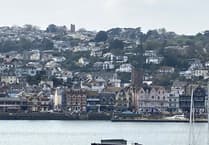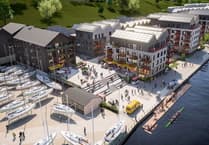SCUBA divers have launched an appeal to find the relatives of those who perished on the first Royal Navy ship to be sunk in the First World War .
It comes after a team of divers including Mike Rowley, of Dartmouth’s MV-Maureen branch of the British Sub-Aqua Club, identified a lifeboat and wooden decking still intact on the wreck of the HMS Amphion.
They spent five days exploring the wreck of the Pembroke-built vessel, which sank after hitting a mine on the second day of the conflict, with the loss of 132 British lives, including men from Devon and Cornwall.
The team also dived on the wreck of the German minelayer Königin Luise, which laid the mine that sunk the HMS Amphion, 40 miles off the Essex port of Harwich, on August 6, 1914.
Retired Devon mechanical engineer Mike Rowley is a BSAC national instructor, and head of technical diving for BSAC. He joined the expedition, organised by Dave Lock, diving officer for the Ipswich Sub-Aqua Club iDive.
Now the team wants to trace relatives of those who lost their lives when the ship sank, as well as descendants of those who survived, under the command of Dublin-born Captain Cecil H Fox.
The condition of the wreck, including the presence of the lifeboat and the still intact wooden decking, will now be reported to the UK Hydrographic office to update British records.
The last report lodged by a survey ship in 1995 said that the vessel was upright and broken into two pieces, 50m apart.
Mike, a member of BSAC’s national diving committee, said: ‘Diving on the Amphion was really interesting, although the visibility wasn’t good. We had around five metres that’s all. The ship is upright but leaning at an angle of about 15 to 20 degrees to starboard.
‘I personally didn’t see the lifeboat that some of the other divers did, but I did see some of the wooden decking that’s still very much intact. However, I did see three guns on the Amphion.
‘It’s difficult to say what size guns they were but they weren’t six-inch guns. The barrels were between eight and 10 feet, with a diameter of around three to four inches. We will have to research the size of guns she carried to be certain.
‘The fact there’s no evidence of any machinery seems to me to confirm that the ship hit the mine amidships and that broke her back and split the wreck into two distinct sections.’
Mike, who began diving in 1976, says diving on the wreck of the Königin Luise was easier, as the visibility was far better.
He said: ‘The wreck is sitting upside down and quite a bit of the bow section is now hidden under sand waves. But the stern is relatively complete, with rudder and shaft clearly visible.
‘The propeller has gone but I suspect that has been salvaged by either Dutch or Belgian commercial salvagers. It’s not a wreck that’s protected by British legislation, I’m afraid.’
He added: ‘Both wrecks now have an abundance of marine life living on and around them. We saw a lot of crustaceans, crabs and lobster, and shoals of whiting, pollock and cod as well as other species of fish.
‘As responsible BSAC divers, we recognised that both wrecks are war graves and treated them with respect and, of course, we would never remove anything from any wreck. We did take as few moments during the dive to reflect on the lives that were lost.’
Dave Lock, a BSAC council member, said diving on the wreck of HMS Amphion had been a long-held ambition. He said: ‘I read about the Amphion and the story grabbed my imagination.
‘She was a cruiser that was sent, along with four destroyers, to investigate reports of a German ship mine laying in the North Sea at the start of the First World War. They found the Königin Luise, still laying mines, and sunk her with gunfire.’
The British ships rescued 75 German sailors before continuing their patrol toward the Dutch coast.
‘It was the Amphion that moved in close to the Königin Luise and delivered the fatal shots.
‘Unfortunately, as they sailed for home, the Amphion struck one of the Königin Luise’s mines, which exploded below her bridge.
‘She sank pretty quickly with the loss of 132 men, one officer and 131 ratings. An unknown number of rescued German sailors from the Königin Luise also perished.’
The Amphion, built in Pembroke Dock, Wales, was part of the 3rd Flotilla, sent to patrol the North Sea between Harwich and the German sea area of Heligoland Bight, following the outbreak of war on August 4, 1914.
On the morning of August 4, the former Hamburg-Holland ferry Königin Luise, which had been converted into a mine layer, was spotted in the Thames estuary.
Two of the 3rd Flotilla destroyers, the Lance and the Landrail, opened fire on the enemy ship and were soon joined by the HMS Amphion.
The Konigian Luise was badly hit and sank – in the first British victory of the war, and the HMS Amphion crew rescued 21 of the German crew from the wreckage.
Soon after the HMS Amphion helped protect a liner, the St Petersburg, which was carrying the German ambassador and his staff back home following the outbreak of war, and was entitled to diplomatic immunity.
Then disaster struck at 6.45am when the HMS Amphion struck one of the mines previously laid by the Königin Luise.
The ship’s bridge was destroyed, killing all the forward gun crew and leaving the captain unconscious.
When he regained consciousness, Captain Fox stopped the engines, but the ship’s back was broken and she was already starting to sink.
Twenty minutes after the mine struck, the surviving men, officers and captain were forced to abandon ship, and soon the vessel exploded and debris fell on the rescue boats, killing yet more men. After a further 15 minutes, the HMS Amphion had sunk.
Captain Fox was transferred to the Undaunted and took a prominent part in sinking four German destroyers off the Dutch coast on October 17, 1914.
He was also in the Cuxhaven raid on December 16, 1914, and lived on until 1963.
Included in the British survivors was Lieutenant Edward Fegen, who went on to captain the Jervis Bay in the Second World War and was awarded a posthumous Victoria Cross.
Many of the survivors of the HMS Amphion suffered severe burns. Among those who those who perished on the ship included men from Devon and Cornwall, as well as other parts of the UK and Ireland.
Dave said the wreck, which lies around 40 miles off the British coast having sailed from the port of Harwich in Essex, is protected, under the Protection of Military Remains Act 1986, which means it can be dived only on a ‘look but don’t touch’ understanding.
Dave said: ‘She sits in around 37m of water and stands three or four metres proud of the seabed. The wreck is partially covered by sand waves which is caused by sand and silt piling up through tide movement.
‘The Amphion has actually split into two sections, the stern and her bow.
‘We only dived on the bow section which sits upright with the hull still intact.
‘There is a great deal of wooden decking which is still visible and shows that they must have used good quality timber for it to have survived 102 years under the North Sea.
‘Poignantly, considering the loss of life, we also saw a lifeboat which is still attached to the wreck. I only glimpsed it as it was some distance from where I was diving but it drives the message home somehow that this is a war grave.’
Dave added: ‘The lifeboat and decking may have been seen by other divers before but they may not realised the significance.
‘We’re pleased to be able to inform the UK Hydrographic office of what we’ve seen so they can update public records.’
Issuing a call for relatives of those who perished during the action to get in touch, Dave said: ‘I would love to hear from anyone who lost a relative on either the Amphion or Königin Luise.
‘It’s always a bonus to be able to hear and be able to piece together some of the stories surrounding any shipwreck.’
Others on the trip were iDive members Paul Mann, of Felixstowe; Matt Yates from Wattisham; Paul Shannon from Ipswich; Raj Mistry, of Otley, near Ipswich; and Neil Turton of BSAC branch Cold Feet Divers.
Dave, a retired radio engineer, added: ‘We did have a few moments of quiet reflection as we dived on the wreck.
‘And, of course, as responsible BSAC divers we would never touch or remove anything from any wreck.
‘We did though take photographs so we can show its condition and what remains of what was once a warship that carried a crew of 289 men.’
Dave said that on the same diving expedition he also dived on the Königin Luise, which he said was still very much intact.
He said: ‘It was a really good dive in great weather and what we saw was once again some very solid engineering. The wreck lies upside down but the engines and turbines are clearly visible.
‘We covered the whole wreck and recorded its condition and took photographs. It was quite strange seeing the wreck of a German minelayer that was sunk by gunfire from the very ship it itself sunk with one of its mines.’
BSAC is the national governing body for scuba diving and is made up of 120 dive centres and 1,000-plus family friendly and clubs, run by volunteers.
It represents more than 30,000 scuba divers and snorkelers and welcomes new members from complete beginners upwards including those who have trained with other agencies.
Mary Tetley, chief executive of BSAC, said the diving expedition led by Dave Lock is an example of the work divers do in recording and protecting historical wrecks right around the British coast.
She said: ‘BSAC divers have played a big part in recording and protecting many wreck sites that are an important part of our heritage. And divers have also discovered many new sites, therefore helping historians and archaeologists tell important stories about our history.’
She added: ‘I’m delighted Dave and his team dived upon the Amphion and were able to record its condition while photographing the wreck so future generations can learn the story behind the sinking of the first Royal Navy ship to be sunk in the First World War.’
Dave said he hopes to return to the wreck of the Amphion so he can dive on the stern section, which they have located, but running diving expeditions so far off shore takes careful planning.
A full list of those who lost their lives when the HMS Amphion sank – and those who survived – is available at http://www.naval-history.net/xDKCas1914-08Aug.htm.
For more information about iDive Sub Aqua Club, visit http://www.idive.org.uk/.
For more information about BSAC go to https://www.bsac.com/Default.asp or follow the organisation on Facebook or Twitter @BSAC DIVERS.




